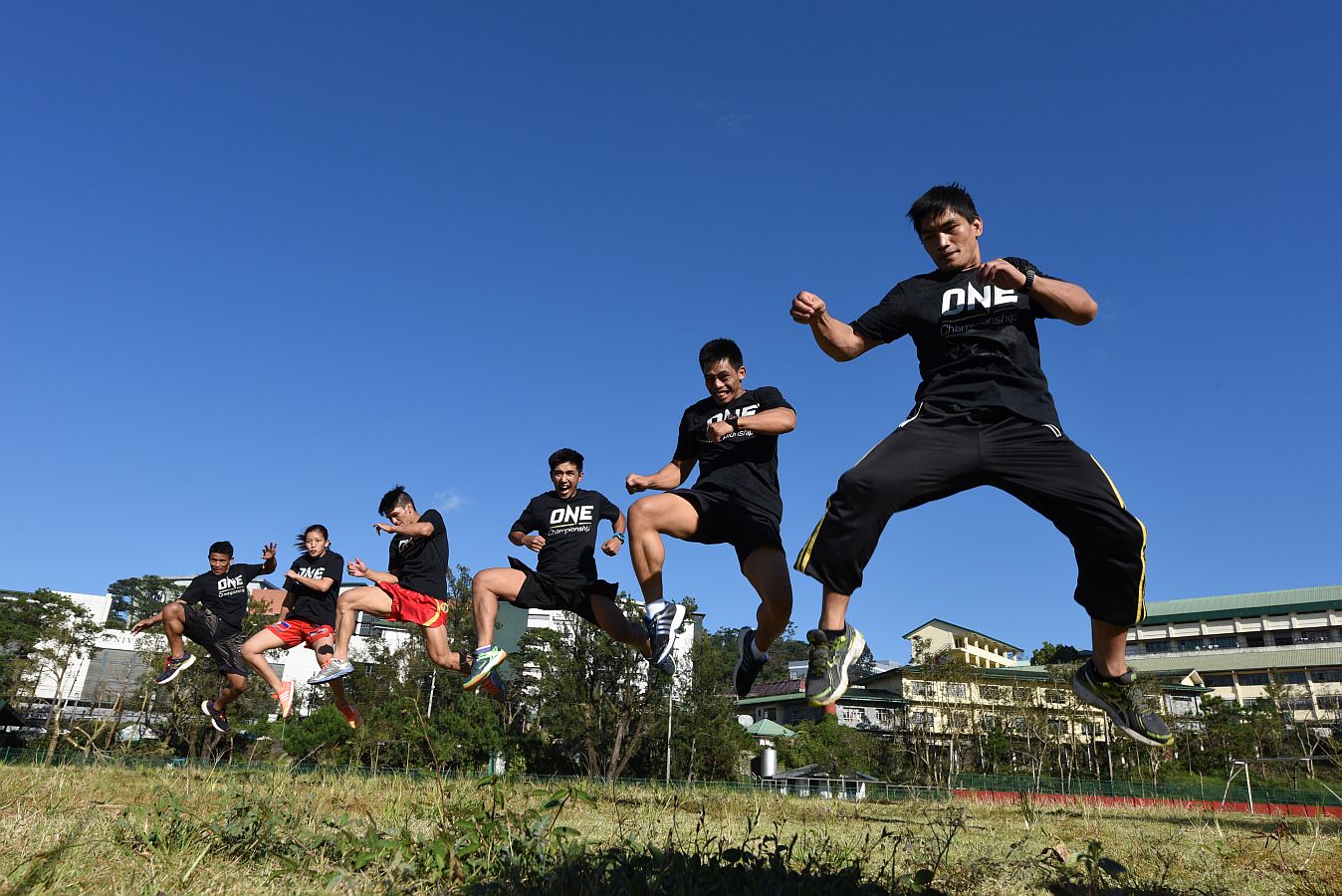Cordillera mixed martial arts battlers are legends in the making

(From Left to Right) Edward Kelly, April Osenio, Danny Kingad, Geje Eustaquio, Honorio Banario, and Eduard Folayang show off their skills at the Burnham Park Athletic Bowl. Folayang is fighting to claim the light weight title of defending champion Shinya Aoki on November 11 in the One Championship event at the Singapore Indoor Stadium. The rest of the team are competing in the One Championship event scheduled in Manila on December 2. INQUIRER Photo/EV ESPIRITU @eespirituINQ
BAGUIO CITY—When Eduard Folayang pinned his champion Japanese foe with a flurry of punches during their recent championship fight at Singapore Indoor Stadium, the Cordilleras celebrated the coronation of an “Ulo ti Manggugubat,” or warrior chief.
Not a mere Ilocano honorific, the title means a lot to victorious fighters of Igorot origins like Folayang, the newly crowned One FC lightweight champion.
The well-built, 5-foot-7 Folayang (17 wins, 5 losses) represents a fresh breed of tough-as-nail mixed martial arts fighters from the Cordilleras who now fight internationally with impressive results.
Generally proficient in wushu and armed with a unique style of grappling, the MMA mountain fighters are feared by foes and adored by their legions of local fans.
“Folayang is an interesting foe with a very unique style, like those in his team,” says the respected ground fighter Marat “Cobra” Gafurov, whom the Filipino wants to fight next after dethroning submission artist and MMA legend Shinya Aoki.
Unknown to many, fighters from the Cordilleras have reaped honors for the country way before the sport caught national attention.
Mixed martial arts started underground here and gained followers only in the 1990s, when the Universal Reality Combat Championship (URCC) staged fights featuring foreign battlers.
Since 2004, Cordillera fighters from the “Team Lakay” stable have dominated the sport, taking off from the career of team founder Mark Sangiao, also Folayang’s coach.
Sangiao, who bagged the gold medal in wushu’s sanda 60-kilogram division at the 2001 Southeast Asian Games in Kuala Lumpur, was bitten by the MMA bug in 2002, when he qualified for the first time to fight in URCC.
“I lost my first fight but I learned a lot from that experience,” says Sangiao. “I realized what skills I lacked and what skills I needed to work on.”
Armed with better skills in 2004, he won the URCC bantamweight title and became the toast of many Cordillerans who soon followed him in the sport.
Wushu athletes
That same year, Sangiao started Team Lakay with fellow enthusiasts from the region. Initially, he wanted to call the group “Wushu Lakay” because it was composed of wushu athletes from Baguio City and surrounding towns.
Although “lakay” is Ilocano for old man, it is also a term of endearment among male friends. “At that time we called each other ‘lakay,’ to mean ‘brother,’” Sangiao says.
Starting out with 15 members, six of whom were active MMA fighters, Team Lakay has grown into a 200-member outfit. Thirty of its active fighters are either champions or are ranked high up in MMA’s totem poles.
Before Folayang, another team stalwart, Dave Galera, captured the URCC bantamweight belt and went undefeated until his retirement in 2010.
UFC fighter
Blessed with fine grappling and boxing skills, Galera also became the first Cordilleran to qualify for the more prestigious Ultimate Fighting Championship (UFC). Roldan Sangcha-an and Mark Eddiva have since followed Galera in the United States.
Team Lakay recorded its finest years in the URCC in 2007, when its fighters won titles in the finweight, flyweight and welterweight divisions.
Among its most recent stars are Rey Docyogen, who held the finweight belt until he retired in 2015; Kevin Belingon, the reigning flyweight king; and Folayang, who ruled the welterweight belt until he entered the international arena via One FC in 2013. Honorio Banario won URCC’s lightweight title in 2010 and went undefeated until 2013, when he followed Folayang overseas. Team mainstay Eddiva still holds the featherweight title.
Team Lakay fighters are also making waves abroad. Banario won a featherweight fight in One FC in Malaysia in 2013 and Crisanto Pitpitunge prevailed in a bantamweight fight in the Pacific Extreme Championship in Guam in 2011.
Learning from mistakes
Perhaps because of the team’s success, foreigners now train with Team Lakay, which prides itself in using a program that has evolved “from the mistakes in the ring,” says Sangiao, a criminology graduate and teacher.
“As head coach, I learned from my experience,” he says. “In every fight we enter, win or lose, there is always a lesson to be learned. When we were starting, our signature moves were [patterned after] kick boxing and wushu. Later, we realized we had to learn other martial arts disciplines.”
Starting out without its own gym, equipment or sponsor, Team Lakay now operates gyms in Baguio, Benguet and La Union.
“I used to borrow money for my international fights,” Sangiao recalls.
Compared to boxing, the MMA’s fan base pales. But “given the attention it is gaining and the fan base it has developed through the years, MMA has a bright future in the country,” says Sangiao. —With a report from EV Espiritu
